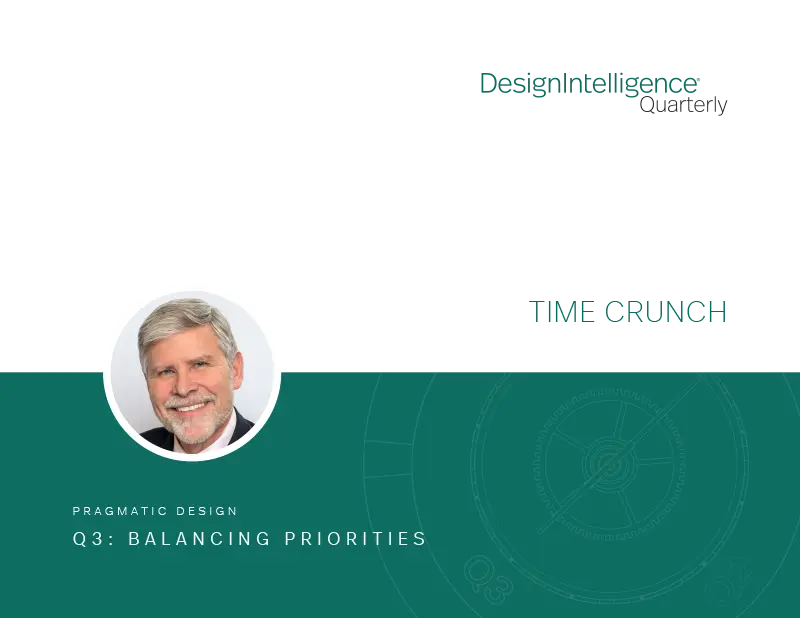Time Crunch
by Scott Simpson, FAIA
Senior Fellow, Design Futures Council
July 5, 2023
Scott Simpson explores an infinite, yet limited, resource.
Time is a funny thing. We can’t see it, taste it, smell it or weigh it. It’s not even a “thing.” We know from Einstein that while time doesn’t have a “size,” it can stretch or shrink depending on the position of the observer, and so it can have different values based upon who’s doing the measuring. Yet time – or the lack of it – seems to govern everything we do. How are we supposed to “manage” something so slippery?
The fear that we are running out of time is so universal there’s even a special word for it in German: torschlusspanik. When it comes to managing time, there never seem to be enough hours in the day to get everything done. The best-laid plans can easily be knocked askew by a bombardment of phone calls, emails and various other interruptions, not to mention the leftover items from yesterday’s to-do list. We often fall prey to unrealistically optimistic assumptions about how long it will take to get something done (especially when other people are involved!). It’s a constant game of catch-up with no end in sight.
Yet the truth is that time is an abundant resource. Everyone on Earth, rich or poor, has all the time there is – the full allotment of 24 hours per day. Nobody gets more and nobody gets less. So, it follows that the problem is not the amount of time that we have, but rather how we choose to use it.
Time is like money in that it can be either spent or invested. Time spent is frittered away, but time invested leads to real progress. Choosing between the two can be tricky. Trying to do too much all at once is counterproductive, because in the scramble for speed it’s easy to make careless mistakes. A good rule of thumb is that if there are more than three priorities, there are no priorities. The rest are bugs on the windshield, serving only to obscure our forward vision.
While some people are good at “multiplexing” (working on several things simultaneously), most are not. They may flutter from task to task like a butterfly, creating an illusion of productivity, but in fact nothing really gets done with the care it should. Ironically, the best way to get fast results is to go slow. Take the necessary time to do things right the first time and you won’t have to mop up the mistakes later. Another great way to save time is by deciding not to do something in the first place. Separate the wheat from the chaff and only take on those things that are truly necessary. The rest can be delegated or discarded.

When it comes to setting priorities, there are two kinds: the things that are most important and the things that must be done first. They are rarely the same things. Tackling a job without laying the proper groundwork pretty much guarantees suboptimal results.
With that in mind, what’s the best way to organize the time we do have? A good tactic is to think backward. Start at the end: What is the desired result? Then work in reverse from there, step by step, until you arrive at the beginning. Now you have a plan: You know where to start and how to get from A to Z to produce the results you want. This approach helps keep things in focus, but can be counterintuitive for designers, who are fond of the “iterative process” of repeatedly processing several different options simultaneously until, whether by inspiration or exhaustion, the “right” answer finally emerges.
When it comes to design, it’s relatively easy to come up with many intriguing options, but it can be devilishly difficult to choose the one, above all others, that will be carried forward as the final solution. This is because choosing one requires forsaking all others, and designers tend to cling to any and all ideas that might eventually bear fruit. Yet to advance a project, decisions must be made. That is the only way to make progress; there must be roadkill along the way. (The “-cide” in “decide” has the same root as homicide, suicide and insecticide!).
While effective time management may seem difficult, it needn’t be. Just know in advance there will be more things to do than you can personally tackle in a day. Choose the ones that matter most and do those first. Delegate the rest. Any tasks that do not make the first or second list are unlikely to be that important. Plan the day in reverse so you can focus on what’s most important and why and keep the rest off your radar screen. Don’t overload your daily agenda; trying to pack too much in will only create needless stress. Here it helps to be mindful of Parkinson’s Law: “Work will expand to fill the time available for its completion.” If a task is expected to take two hours, it will, but if just one hour is allotted instead, it’s likely the work will still get done. Sometimes faster is better.
Time is the one thing we will never run out of; there is always more to come. It’s a bottomless bank account. Learn to treat time as a friend, not an enemy. Think of it as enabling rather than restricting. Then think about Parkinson’s Law in reverse: There’s always enough time to do something right, but there’s never enough time to do it over.
Scott Simpson, FAIA, is a senior fellow of the Design Futures Council and a regular contributor at DesignIntelligence.


